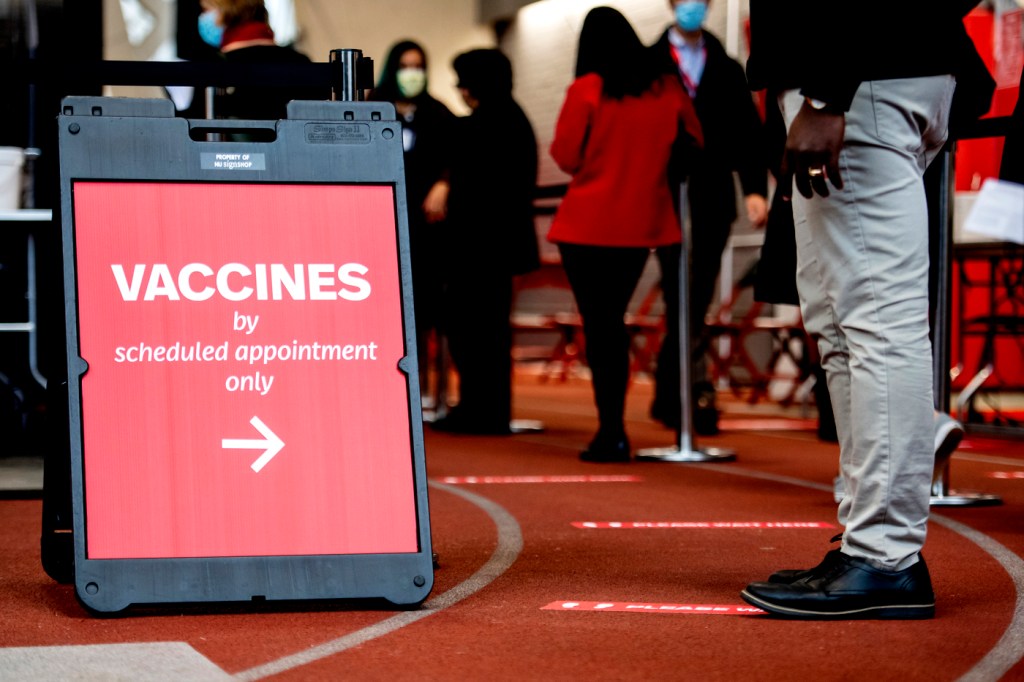Why is the U.S. behind on its COVID-19 vaccination goals?

The symbolism was clear.
In early May, President Biden set a goal for 70 percent of the adult U.S. population to have received at least one dose of a coronavirus vaccine by July 4. That benchmark was selected because it approaches the immunity levels needed to prevent large outbreaks of COVID-19. The aim was freedom from most pandemic restrictions and worries by the Independence Day holiday.
We almost made it.
As of the Fourth of July, 67 percent of people over the age of 18 had gotten at least one shot, according to the U.S. Centers for Disease Control and Prevention. Of all adults in the U.S., 58.1 percent have been fully vaccinated.
But vaccination rates have slowed considerably from the days when newly-eligible Americans frantically refreshed their internet browsers in the hopes of snagging an appointment just as new ones were made available. And variants of SARS-CoV-2, the virus that causes COVID-19, are wreaking havoc in unvaccinated communities across the U.S. Public health officials say that the nation still needs to increase vaccination rates in many places in order to prevent more outbreaks—and deaths.
The key to getting more people on board, Northeastern experts say, is to shift the focus from a national public health campaign to localized, grassroots initiatives. The people that an unvaccinated person already knows and trusts matter.

From left to right: Assistant Professor of Communication Studies Susan Mello and Neil Maniar, director of the Master of Public Health program and a professor of the practice in the Bouvé College of Health Sciences. Northeastern File Photo and Photo by Matthew Modoono/Northeastern University
“Now we have the steepest part of the hill to climb in terms of getting to our vaccination goal,” says Neil Maniar, professor of public health practice and associate chair of the Department of Health Sciences and director of the Master of Public Health program at Northeastern. “It’s going to require more tailored interventions.”
The early vaccination rush was a lot like what happens when Apple releases a new iPhone, Maniar says. First there are the early adopters, who are like the people who will line up outside the store for a new smartphone. “They’re the ones who want to be the first ones to get something done,” he says. “And we saw the same thing with vaccinations.”
After that eager group comes another wave, called the early majority. Typically, Maniar says, this group will make up about half of the people who will ultimately participate in a public health intervention. “That’s sometimes the easiest part,” he says. And that group has largely already been vaccinated to protect against the coronavirus.
Then comes the late majority. This group waits to see their friends, family and other people they trust get vaccinated first. After them comes the most hesitant people, Maniar says, “the ones who are like, ‘I don’t need an iPhone, I’ve got my flip phone and it’s working great,’ or ‘I don’t need to get the COVID-19 vaccine because I’m 25 and I’m healthy and I’m young.’”
Those dynamics may be important to understand some of the remaining unvaccinated individuals across the country.
In some places, the late majority has already largely begun to get vaccinated, because the early majority was a large swath of the population. In those areas, if you were hesitant yourself, you were bound to know someone who had gotten vaccinated that you could talk to about the experience.
But vaccine rates have varied greatly from state-to-state, region-to-region, and even town-to-town. By June 28, 70 percent of the adult population in 21 states had received at least one shot. Six states, including Massachusetts, had surpassed 80 percent, too. But 15 states, many of which are in the South and Midwest, had administered at least one shot to fewer than 60 percent of adults.
In the places where vaccination rates remain low, there are a lot fewer of those person-to-person interactions about the shots within social circles.
“This piece around not having folks in someone’s network who they can look to and say, ‘this person got vaccinated and now I’m going to get vaccinated,’ takes an important variable out of the equation, which is something that we’re going to need to address,” Maniar says.
This vaccination divide tends to fall along political lines, with states that voted for President Donald Trump in 2020 largely falling behind those that voted for Biden. Within states, vaccination gaps persist along socioeconomic divides, too.
For some people, it’s about access, Maniar says. Vaccination sites might have been inaccessible to those who rely on public transit, for example. Or, he adds, they might not have had access to healthcare in other ways that left them with unanswered questions about the safety of the vaccines, or simply where, when, and how to get a shot.
A more localized approach to public health education about the vaccine might help, says Susan Mello, assistant professor of communication studies at Northeastern who studies health communication. Volunteers going door-to-door to help answer questions and provide information might provide a more neighborly connection, she says. “Doctors and pharmacists also need to continue having those conversations with their patients.”
There’s a trust factor that is playing an important role in the unvaccinated population, Maniar says. “Giving people the opportunity to get their vaccine from a trusted source is really important, whether it’s their healthcare center, their primary care provider, a local pharmacy, whatever it might be,” he says.
And a trusted source doesn’t necessarily have to be in healthcare, Maniar says. Community leaders in other spaces, neighbors, or hair stylists could also engage in conversations about the coronavirus vaccine that might encourage others to get their shots.
“We think about who is trusted within communities, really getting their buy-in. This means that as a public health community, we think about, who else do we need to work with? Who else do we need to engage?” Maniar says.
Plans to address the political divide on vaccines could take a page out of the climate change communications playbook, too, Mello says. If public health messaging can make connections between conservative values and the coronavirus vaccine effort, that could help depoliticize the vaccines.
For media inquiries, please contact Jessica Hair at j.hair@northeastern.edu or 617-373-5718.





